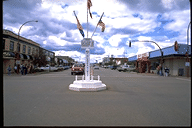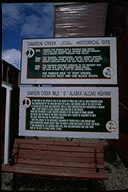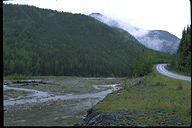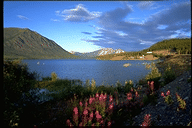
Rocky III
by Philip Greenspun; created 1993-1996
Home : Travel : Great Trips : Rocky III
 Work on the Alaska
Highway began just four months after the Japanese attacked Pearl Harbor. Pentagon
strategists decided that the next logical Japanese move would be to invade
Alaska: "whoever controls the Aleutians controls the Pacific." Before obtaining
Canadian consent, the project was announced in Washington and troops were sent to
Canada. Dawson Creek, British Columbia is Mile 0.
Work on the Alaska
Highway began just four months after the Japanese attacked Pearl Harbor. Pentagon
strategists decided that the next logical Japanese move would be to invade
Alaska: "whoever controls the Aleutians controls the Pacific." Before obtaining
Canadian consent, the project was announced in Washington and troops were sent to
Canada. Dawson Creek, British Columbia is Mile 0.
"At this spot in the spring of 1942 at the height of WWII, the U.S. Army engineers began the construction of the overland route to Alaska. Nine months later at the cost of over $140,000,000 the road was completed. This is a road construction feat unsurpassed in modern times. 11,000 troops and 16,000 civilians were employed in this project.
There are 133 briges [sic] & 8,000 culverts embodied in the 1523 miles of gravel highway. The rattle and roar of the mighty bulldozer was a source of amazement to both the local white man and the northern Indian.
Over this lifeline to the Northwest, thousands of troops, food & war supplies have been transported. In more recent times, the mighty H-bomb was known to travel this route. It was maintained by the Canadian Army until April, 1964. Maintenance was then taken over by the Dept. of Public Works, Ottawa."
--- sign in front of Alaska Highway Museum
 You'd expect the
Alaska Highway to have spectacular scenery, but the first portion rolls through
flatland vaguely reminiscent of northern Minnesota. The forest on both sides of
the road has been brutally clear-cut and indifferently replanted. One gets a
palpable feeling of the rape of the wilderness.
You'd expect the
Alaska Highway to have spectacular scenery, but the first portion rolls through
flatland vaguely reminiscent of northern Minnesota. The forest on both sides of
the road has been brutally clear-cut and indifferently replanted. One gets a
palpable feeling of the rape of the wilderness.
Although the Highway is mostly paved now, the local economy is based on delivery of three services: windshield repair, tire repair, and (most worrisome) welding. I expected to need the first, didn't think I'd need the second, and prayed I wouldn't need the third.
"Park the vehicle on a firm and level surface." -- Dodge Caravan Owner's Manual
The last place that fit this description was 400 miles back in Dawson Creek. My inspiration for reading started at 60 mph with a peculiar sound and a pronounced desire on the part of my minivan to exit the highway to the right. I managed to keep the car on the road and braked lightly to a stop with the car 25% off the road.
My right front tire was completely flat. The shoulder, as along so much of the Alaska Highway, consisted of a 20-foot-deep ditch. Traffic was pretty light, but consisted mostly of huge motorhomes, tandem semi-trailers, and flatbeds hauling oversized mobile homes. Hills front and back prevented anyone from seeing me.
I'd no alternative but to drive on the rim until a better tire-changing spot could be found. I drove about one quarter mile to a spot with a wider shoulder and better views for traffic, but still was only able to get the car 50% off the road.
Task #1: get the spare tire out from under the car.
It was easy enough to winch down from the chassis, but there was no way to slide it out from under the car. The spare was hemmed in on all sides by the rear tires, the exhaust system, and the trailer hitch. I considered jacking up the driver's rear side of the car, but didn't relish operating a scissors jack smack in the middle of the Alaska Highway. At this point I congratulated myself on having made my Will just before leaving Boston. Taking all 500 lbs. of junk out of the car lifted the trailer hitch enough that I was able to drag the spare out.
Task #2: figure out if it would be possible to jack the car.
The highway here is dramatically crowned and the shoulder drops down at a 10 degree angle at least. The only way to level the car would in fact be to park it directly over the yellow centerline, so "level" was out of the question. "Firm" was not an adjective that one would normally apply to the dirt-and-gravel shoulder, but I didn't think towing the car 30 miles to the nearest gas station was an option.
Keeping the spare first and then the flat tire under the rocker panel--in case the car fell off the jack, it would theoretically come to rest on the spare wheel rather than on the brake rotor--I managed to jack the car with a minimum of trepidation.
"And I will cast abominable filth upon thee, and make thee vile, and will set thee as a gazingstock."
-- Nahum 3:6
By the time I'd finished changing the tire, I was covered in black or brown filth from head to toe. As the exterior of the car was so encrusted in mud that the license plate was no longer readable, it should have come as no surprise that the stored-under-the-car spare was thoroughly filthy. Nonetheless, I couldn't believe the sorry state of my clothing and the dirt under my fingernails.
Changing the tire wasn't the best hour of my trip, but I did get something positive out of it: the knowledge that, Kitty Genovese notwithstanding, Real North Americans won't abandon their fellow human being to his fate. At least half of the passersby stopped to offer assistance, including two women traveling with two babies in car seats (being a true gentleman, I naturally didn't deprive them of the opportunity to get some "hands-on" experience with a lug wrench). A pyramidally corpulent Maine couple stopped in their motorhome and we had a pleasant time recalling our last meeting in a North Dakota gas station. Even during long intervals between trucks, I wasn't lonely; crowds of mosquitoes and a few wasps gathered to observe and assist.
 A day or two later,
in Whitehorse, Yukon, I noticed that the scenery had turned beautiful. The three
hour ride south to Skagway, north edge of the Alaska Marine Highway, is probably
the prettiest highway up north. The next section of the Alaska Highway toward
Fairbanks passes between blue/green Kluane Lake and the 20,000' Saint Elias
Mountains. For real adventure, one can head north on the Klondike Highway, 7
hours to Dawson City, and then drive 10 more hours on gravel across the Arctic
Circle to Inuvik, Northwest Territories. That's as far north as one can go on a
public road in North America.
A day or two later,
in Whitehorse, Yukon, I noticed that the scenery had turned beautiful. The three
hour ride south to Skagway, north edge of the Alaska Marine Highway, is probably
the prettiest highway up north. The next section of the Alaska Highway toward
Fairbanks passes between blue/green Kluane Lake and the 20,000' Saint Elias
Mountains. For real adventure, one can head north on the Klondike Highway, 7
hours to Dawson City, and then drive 10 more hours on gravel across the Arctic
Circle to Inuvik, Northwest Territories. That's as far north as one can go on a
public road in North America.
If you are actually planning to take this trip, you may wish to look at the user-contributed Related Links page.
Return
to the Great Trips index page
Text and pictures copyright 1993-1996 Philip Greenspun